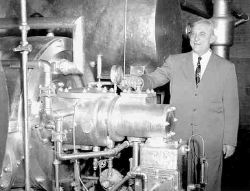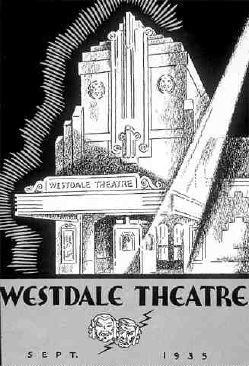Additional comments from article’s writer Bernard Nagengast, a member of the Society’s Historical Committee, Feb 14, 2017.
The photo shown in the article is of the first Carrier centrifugal chiller from the early 1920s. The man in the photo is Willis Carrier. There is no direct connection to the Westdale Theatre, however if the theater had a Carrier AC system, no doubt it would have been a Carrier centrifugal although it would have looked very different from the 1920's photo since Carrier made many improvements in the system by 1935.
The compressor Carrier is standing next to was custom made by Jaeger in Germany in the 1920s. The centrifugal production moved to the USA in the early 1930's (for obvious political reasons) and were made by Carrier Corp. in Newark, NJ.
The early Carrier cooling systems in 1920 used Dichloroethylene (Dilene) refrigerant, then in the late 1920s, they switched to Methylene Chloride (trade named Carrene).
By the time of the Westdale Theatre opened in 1935, I believe they would have been using R11 refrigerant
Bern Nagengast
Air Conditioning Still Cool After 100 Years
By Bern Nagengast and Rob Faulkner

The snowball rolled in 1956.
'Sold out' signs hung in Hamilton storefronts. Farmers read of a chill that made cows give more milk. Tenants rented new, windowless apartments. And once-sweaty Canadians -- at work, home and play -- wondered where the future of air conditioning could lead.
A threshold year, some called it, as the home air conditioning market boomed. Market watchers saw imports rise 140 per cent over 1955. Bosses saw a new way to keep workers working, shopkeepers, a way to attract customers, and a new hum was spreading to Canadian homes.
This is the story of the birth of cool.
'It's an interesting story where you go from people saying, 'You're out of your mind' to the point where it's, 'I've got to have it. I can't live without it,'' said Bernard Nagengast, co-author of Heat and Cold: Mastering the Great Indoors.
'There aren't many technologies that have undergone such a profound change in our perception of the technology, and what it has done to change things,' said Nagengast, an Ohio engineer who has studied the history of air conditioning for 30 years.
By 1956, a late start by American standards, a hot Canadian summer had local and national newspapers raving about the mainstream adoption of air conditioning. It seemed an idea whose time had finally come -- and this week marks the 100th birthday of that idea.
It was exactly a century ago this Wednesday that Willis Carrier of Buffalo laid plans for what's been hailed as the world's first air-conditioning system. On July 17, 1902, the young engineer found a way to control the climate in a Brooklyn, N.Y., printing plant, reducing the waste created when humidity changed the size of paper rolls and made colours inconsistent.
While some dispute Carrier's claim of 'invention' -- and laud earlier pioneering like Dr. John Gorrie's 19th century attempts to fight malaria in Florida with ice-cooled air -- the man behind today's Carrier Corp. kick-started the scientific thinking and marketing of a product that has changed our lives.
Early on, air conditioning -- which, unlike the 19th century's fans and ice, also controlled humidity -- was a financial blessing for industrial plants that depended upon stable climate conditions. The lithographers at the Sackett-Wilhelm plant in Brooklyn soon had company.
Before air conditioning, cotton threads snapped, cigarette machines jammed, film attracted dust and chocolate went grey with fluctuating heat and humidity. Cool and dry air, the captains of industry learned, could also make factory workers more comfortable, more productive and less prone to call in sick.
'For the first 20 years, it was almost entirely industrial use,' said Jon Shaw, Carrier's communications manager in Syracuse, N.Y. It was only a matter of time, however, before the gargantuan systems shrank in size and grew in popularity.
The North American public, in the thousands, first felt the new chill at the St. Louis World's Fair in 1904, which cooled the 1,000-seat auditorium of the Missouri State Building. Most, however, had to wait until movie theatres installed air conditioners in the years after the First World War.

The summer blockbuster, now a multimillion-dollar staple in Hollywood, was only possible when air conditioning let theatre owners stay open year-round. Rather than close shop in the summer heat, theatre owners could market their cool air and cool flicks as the perfect summer outing.
In the deadly heat wave of 1936, which turned Hamilton General Hospital into a 37C heat trap, locals found shelter in the new Westdale Theatre. Opened in 1935, it was an air-conditioned refuge where they could cool off and catch the latest Bette Davis film for 20 cents.
The theatre's first program boasted of 'the latest air-conditioning,' cutting-edge Dunlopillo seats, a non-reflecting screen and fittingly 'British' content that opened and closed with God Save the King.
Other movie house banners bragged 'it's 20 degrees (Fahrenheit) cooler inside,' thereby turning cool air into the hottest ticket in town. Once the target of moralists worried about unwashed masses in dark, unventilated spaces, theatres soon rivalled amusement parks and ball diamonds as spots for summer leisure. This indoor bliss would also bring us the mall.
Starting with the New York Stock Exchange in 1901, mechanical cooling let architects break the rules of urban design. Time was, office buildings were built according to L, T or H-shaped floor plans, which maximized the number of windows to catch any available cross-breeze.
'Air conditioning let you use more space for the actual building,' Nagengast said. Builders filled whole city blocks with bricks and mortar, building up instead of out. They got rid of the window awnings (no need for shade), added more offices (no need for windows) and erected glass towers immune to the outside world -- as long as the air conditioner kept the inside world a pleasant 22C.
And millionaire Charles Gates, whose Minneapolis mansion became the first air-conditioned home in 1914, wasn't the only person who wondered: 'If I can be cool at the office, why not at home?'
By 1929, refrigerator maker Frigidaire created a small, expensive 'room cooler' that could be installed in homes or small stores. This led to the window box unit, air conditioners in cars and, later, the rise of new house designs. Widespread adoption of so-called 'comfort cooling,' however, slowed until after the Great Depression and Second World War.
'We can now create our own climates indoor and forget about the naturalistic approaches to home design, at a cost,' said Leslie Oliver, a retired heating and refrigeration expert now working on a Web-based museum of air conditioning.
For example, the Aurora-based historian lives in an Italianate-style home built in 1860 with ceilings that soar 10 feet high, a design feature used to trap hot air above the heads of residents. Old-time windows once opened from the top so hot air wasn't mixed around, Oliver says, while awnings and verandas made some much-needed shade.
But homes changed with the arrival of air conditioning. Check out post-war suburbs like those in Levittown, N.Y., or older parts of Canadian cities: single-storey homes have low roofs, large windows sealed to the outside, ceilings of about 8 feet (2.4 metres) and porches just for show or entirely absent.
'Verandas used to be your sun shield so you didn't get direct sunlight in your living room,' Oliver said. It no longer mattered which way your house faced. 'And coloured awnings on homes were once a very stylistic mark of an expensive home.'
As North America's middle class grew in the '50s, the father of the modern suburb, William Levitt, signed a lucrative deal with Carrier to put cooling units into his mass-produced, cookie-cutter homes. 'It doesn't make sense to heat a home in the winter and not cool it in the summer,' Levitt said.
But, as Oliver notes, there were also costs to this new thinking. Without awnings, buildings paid huge sums to cool their exposed interiors. Electrical demand soared, upending our old notion of winter as the season of heaviest use. Later, we learned some coolants were environmental hazards and that coal-fired generators feeding this new demand for power also spewed pollutants into the air that turned to smog at ground level and boosted global warming.
Yet, in the '50s, decorating magazines like House Beautiful and House & Home advertised the cool, new convenience. Window boxes sprouted on the outside of homes and offices. Homes, freed from the need to catch a breeze, could face any direction. And air conditioning made the rules of geography more elastic.
In the United States, it helped reverse a century-long pattern of migration out of southern cities, Nagengast says. Air conditioning was an important reason why eight of the 10 fastest-growing states after 1940 were in the south, among them dynamos like Atlanta, Dallas, Houston and Miami.
Even in Canada, with its cooler weather, the slower spread of chilled air brought change. Air conditioning seemed to reduce allergies to dust and pollen. It boosted summer church attendance. In the age of 'new is best,' it seemed like the fix for everything from crowded classrooms (year-round teaching), traffic woes (pack more buses) and labour strife (cool off workers).
Oliver, the engineering historian, recalls how the early '60s brought cool air to grocery stores like Dominion and Loblaws. New refrigeration tactics allowed the sanitary quick-freeze of meat products. Our use of electricity was reshaped as Canadians cranked up air conditioners all summer.
Gone were the days when a notable like Alexander Graham Bell had to drain his swimming pool and turn it into an ice-cooled living room to stay cool. The inventor -- of the telephone, it should be noted, not the air conditioner -- built ventilators to move air over ice and into the bottom of the pool, which he furnished with a carpet, desk, sofa and armchair.
After Carrier, life got cooler and quieter. By 2000, one in three Canadians had an air conditioner at home. They gathered inside on hot days, maybe to watch TV in a climate of their own design. They shut their doors against the summer heat. They traded the old sounds of the neighbourhood -- barking dogs, crying babies, passing traffic -- for a cool hum.
You can contact Rob Faulkner at rfaulkner@hamiltonspectator.com or at 905-526-2468.
The American Society of Heating, Refrigerating and Air-Conditioning Engineers
www.ashrae.org
Carrier
http://www.carrier.com/carrier/en/us/
Heating, Refrigeration and Air Conditioning Institute of Canada
www.hrai.ca